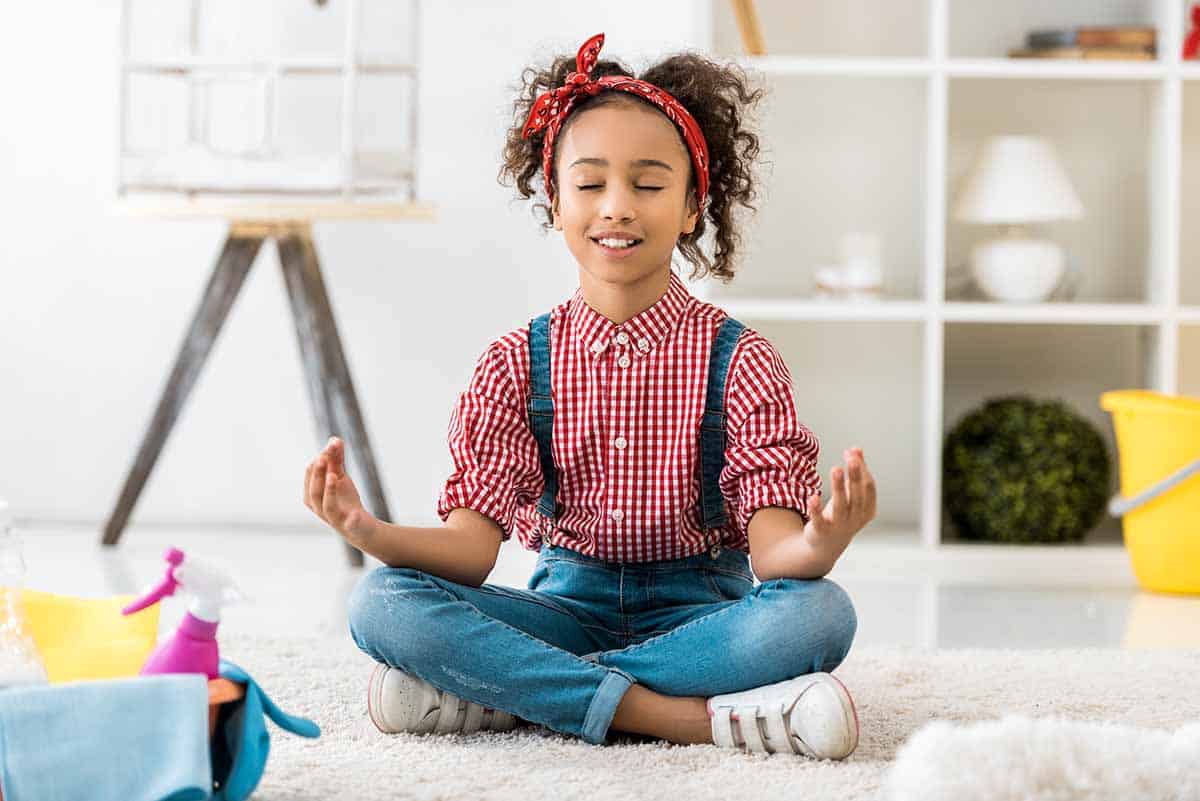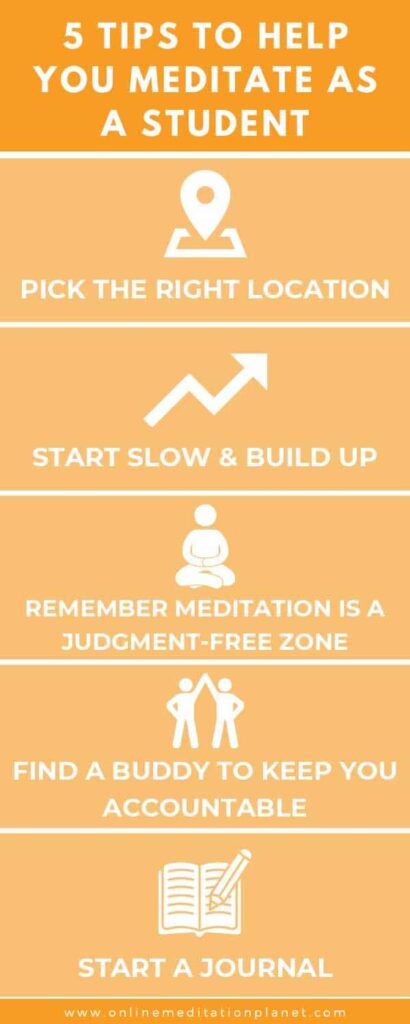Meditation is a highly effective way to help students attain greater academic success and cope with their own emotional and physical responses to stress. While achievement is an outcome, the goal of meditation is to cultivate healthy habits that allow students to better engage their work and the world around them. Meditation is holistic, giving the practitioner the ability to become more mindful of their physical, mental, and emotional state of being.
While meditation may sound intimidating for students, these are five tips that can help give you a solid foundation on which to build:
- Pick the Right Location to Meditate
- Start Slow and Build Up
- Remember Meditation Is a Judgment-Free Zone
- Find a Buddy to Keep You Accountable
- Start a Journal
If you are a student wondering how meditation can give you a healthier sense of yourself that translates into better results in the classroom, read on to discover the multiple benefits of meditation and how you can start this practice.
Article Contents
How Do You Meditate As a Student?
Asking the question of how to meditate begins with time, or specifically, finding it. You may think that your schedule is too tight to add yet another activity. Is meditation worth your investment?
The most important rule for beginning the practice of meditation is to start with a routine that is doable for you. It may work for you to meditate for a short duration every day, every other day, or perhaps just a couple of times per week. Pick a time and stick to it. The full effects of meditation can only be found when it becomes a sustainable and enjoyable habit.
The next question is figuring out which types of meditation you wish to use. Any research you do will reveal an assortment of methods from Metta, breath awareness, and Zen to transcendental meditation.
However, mindfulness meditation is often the best type of meditation for students for two reasons:
- It is a very popular method of meditation.
- The general scope of this form of meditation carries over to most, if not all, of the other forms out there.
The American Psychological Association (APA) Dictionary defines mindfulness meditation as “a type of meditation in which a person focuses attention on his or her breathing and thoughts, feelings, and sensations are experienced freely as they arise.” In other words, the ultimate goal of this meditation is to make the practitioner more aware of the rhythms and movements of their mind and emotions.
The essence of the practice of mindfulness meditation is in controlling and noting one’s breath. This can be done by counting them, reciting mantras as one breathes, establishing an image in one’s mind representing breath, or simply listening to the sounds of your body as you inhale and exhale. Utter attentiveness to your breathing does not mean thoughts or emotions won’t enter your mind, but it gives you an anchor to be aware of them without being distracted by them.
Is Meditation Helpful for Students?
Meditation is beneficial for students for different reasons:
Meditation Helps Students Concentrate
One of the most essential needs for a busy student is retaining information and the ability to think critically. But the sheer amount of input that students receive, along with stress, lack of sleep, and sometimes insufficient diet, leads to a significant inability to concentrate. To retain the fullness and integrity of memories, students must be able to exercise attentional control.
Meditation Helps Students Retain New Information
The practice of meditation is shown to allow for better recall of complete and accurate thoughts. In essence, meditation allows one to slow down the distractions so that the practitioner may better be equipped to note important details and themes from conversations, lectures, and experiences that are happening at that moment.
Meditation Helps Students Reduce Stress
Another related element that meditation positively affects is the reduction of stress. It probably doesn’t come as a surprise to find out that depression and anxiety are strongly prevalent among students.
While the underlying causes of these mental disorders are complex, a key contributing factor is the feeling of being overwhelmed by the volume of tasks and the emotions that accompany them. Mindfulness meditation, when practiced faithfully, gives you the ability to cope with your emotions and the scope of the difficult work that inevitably you face as a student.
Meditation Grows Mental and Emotional Health
As you become more advanced in your mediation practice, you will develop greater mental and emotional capabilities that allow you to truly enjoy living in the present moment. In addition, meditation cultivates a more profound sense of compassion, empathy, and concern for the needs of others.
Academic achievement is an admirable goal, but the science behind meditation can teach you to be a better person in the world!
5 Tips to Help You Meditate As a Student
Here are some basic tips that will help students start off on the right path to regular meditation:
 Pick the Right Location
Pick the Right Location
Picking the spot that feels right is essential to the practice of meditation. You want to find a place that minimizes distractions as much as possible, but it is also a place you want to be. The location that might be conducive for you might not be the place that someone else may pick. Some trial and error may be in order before finding a spot that facilitates a conducive environment for you.
Nevertheless, there are some important characteristics to hold in mind as you search for that optimal place to center yourself:
- Turn Off Your Cell Phone! – Meditation precludes distraction, so make sure that one of the leading distractors is turned off and put away!
- Look For a Place With Few People – Finding a place that is simply quiet is not enough. Look for a place where people are scarcely present.
- You Need to Like the Place – Don’t go to a place just because it’s isolated. It needs to be a place where you feel positive energy and perhaps enjoy visiting for other purposes.
- Find a Place That Is Close – You don’t want a place where you have to hike 10 miles away. Find a place that is close and readily accessible for you daily.
- Wear Comfortable Clothing – Your meditation place needs to be a place where you are not worried about heat or cold and, as such, can dress in a way that allows you to feel relaxed.
With these characteristics in mind, your place can be a room in your home or a favorite spot in the woods. Simply find a place that allows you to relax, be quiet, and turn inwardly.
Start Slow and Build Up
Do NOT be in a rush to become an expert in meditation from the beginning. For meditation to succeed, you must start with a short duration of time (as little as 5 minutes) that is reasonable for you to practice and do regularly. Meditation is not about achieving an end result. Rather it is about allowing your body and mind the opportunity to slow down their rhythms by listening to your breath and simply being attentive to whatever happens at the moment.
Above all, the most important aspect of selecting your time to meditate is one that will allow you to be consistent. Consistency ultimately means daily, but even then, you may want to start out meditating 2-3 times per week. As you train your body for the time you have allotted, you will gradually be able to increase the amount of time and the frequency of your sessions.
Remember Meditation Is a Judgment-Free Zone
As you meditate, you may find yourself letting a thought overwhelm you. You may get an itch that distracts you. A person could barge into your quiet space unexpectedly. Or you just may not feel into meditation for that day.
Do not be hard on yourself! Meditation is not a path to perfection but rather to a place of mind where, in a world of distractions, you have trained yourself to let go of those distractions. It is very common for beginners to think they aren’t meditating correctly or can’t control themselves.
As you practice meditation, your body and mind will find their rhythm that allows you to let a distraction go. And meditation will train you to be present in a stressful moment and not obsess over its outcome.
Find a Buddy
Meditation is, at its core, an individual exercise in that you are focusing on your consciousness and not on anyone else’s. This is in much the same way that, when you exercise, you are concentrating on the work needed for your body. But for both exercise and meditation, finding a partner is an essential way to help keep both of you accountable.
You can meditate with your partner, but your partner’s role is to encourage you to keep your habit. Your partner can also help direct you away from self-judgment and brainstorm with you about different styles and ways of meditating.
In addition to a partner, it is always a good idea to seek out a teacher who can share with you their experience and knowledge with more advanced forms of meditation. Even for simpler forms, a teacher can give you tips that can enrich your daily practice, make you more technically sound, and help you enjoy what you are doing!
Start a Journal
As you proceed on your journey, start a journal to record your experiences of meditation. This doesn’t need to be an arduous task. Every week you can write down a couple of paragraphs about insights, frustrations, or descriptions of your sessions. You want to write down just enough to give a sense of your thoughts for that week, but there is no need to write a novel on your experiences – unless that is helpful to you!
As you grow in your experience, this journal will give you benchmarks that show you how meditation has helped you. Because meditation is a very gradual exercise, the journal helps to show the big picture of your practice. The journal is also an outstanding way to smile and laugh at the things that may have frustrated you before, which in itself demonstrates that it is doing what it is supposed to be doing!
A Great Beginners Meditation Course for Relaxation
For a great way to get students started in meditation, check out this excellent online course here from Sura Flow.
The course is a comprehensive guide for beginners, which walks you through both the mechanics and the philosophy behind meditation. You will gain the confidence and the skills needed to help you develop deeper connections within yourself and with others through the art of meditation.
Conclusion
Meditation is a long-practiced and rich tradition of giving people the physical and mental abilities to handle life’s difficulties. For students, it is an opportunity to cope with the daily grind and rise above it with increased focus and attention to the tasks at hand.


 Pick the Right Location
Pick the Right Location

